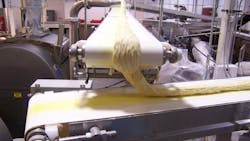Understanding the environment is critical to specifying conveyors
There are a number of different variables to consider when specifying a conveyor. How long does it need to be? How fast will it need to run? What kind of budget is the buyer working with?
These are all pretty standard considerations when choosing a conveyor that best fits a specific need for a process. However, the most important element to consider is environment. Understanding the environment the conveyor is ultimately earmarked for is the most critical piece of the puzzle. Oversights on this part of the specification process can cause delays and corrections that lead to significant costs that could otherwise be avoided.
Many times, in processing, the environment in question would qualify as “harsh.” There could be elements that can cause corrosion. There could be elements in the vicinity that could cause an explosion. There could be hazardous gas, dust or ignitable fibers in the air.
These are all very common threats in processing environments and a run-of-the-mill, off-the-shelf conveyor may not be equipped to handle such environments. It could corrode, explode or fail and then the operator is left with unforeseen, costly downtime. The emergency repair and replacement costs, coupled with the lost revenue due to downtime, is crippling to any organization. These costs can be avoided with more analysis on the front end. The bottom line is that before any purchasing decisions are made regarding the conveyor, the environment must be considered.
Materials selection
If the area the conveyor will be operating in tends to be more corrosive in nature, the frame and return rollers are in jeopardy. In this case, these parts of the conveyor need to be constructed from stainless steel as opposed to aluminum. Additionally, there may be a need to use plastic for the rollers or the internal frame. If the belt needs to be rinsed regularly due to external factors, there are certain features that make it easier to wash. For example, a conveyor with tails that can be tipped up or easily removed should be strongly considered in these situations.
The rollers and bearings must also be sealed. Typically, bearings are open and can attract dust and other contaminants, but if they are completely sealed, they will be safe in a harsh environment
Finally, the belting material must be specified correctly. A material must be chosen that does not react with the substance. Most urethane belts are a good choice, but there may be something in the process that will react with it. Will static discharge be something that will affect the process? If so, there are static dissipative belts that are available on the market.
Motor choice
The most critical decision in terms of safety is probably the motor selection simply because the consequences can be the most severe.
The motor choice for the conveyor in this type of environment is limited. A motor may not qualify for an area if there is an elevated risk for corrosion. In an even harsher environment, where there is substantial risk of an explosion, the motor needs to be "explosion-proof" rated.
These motors are low current but are also completely sealed so as not to set off the reactive material in the area such as explosive dust. In these circumstances, for a motor to be classified as such, it must meet a specific criterion, intrinsically safe or explosion-proof. Beyond these two fundamental terms, there is also a National Electronic Manufacturer Association (NEMA) rating system to classify the degree of hazards present in an environment. There are Class I, II and III NEMA ratings, all dictating how hazardous an environment is that the conveyor motor must qualify for. A Class I environment consists of flammable glass. A Class II environment contains combustible dust, and a Class III area consists of flammable lint or fibers. Depending on the environment in question, the appropriate explosion-proof motor must be selected.
Controls are another piece that need to be considered when specifying a conveyor for a harsh area. Is the motor going to be running at a fixed speed or will it be adjustable? The controls may need to be separated entirely from the environment for protective purposes.
There are so many elements in a harsh environment that can have an adverse effect on a conveyor. Before making a sizable investment in a conveyor for a process, understanding your environment and effectively using that information to make a solid purchasing decision is key.
This will ultimately help avoid unnecessary pitfalls and prevent the costs associated with equipment replacement and lost downtime due to failure. Not to mention, it will also help avoid preventable injuries on the jobsite. By doing the homework on the front end, this will avoid major headaches once the process commences.
James Walker is an account manager at Valin Corporation with 28 years of experience in the industry. Valin is a leading technical solutions provider for the technology, energy, life sciences, natural resources and transportation industries. Valin offers personalized order management, on-site field support, comprehensive training and applied expert engineering services utilizing automation, fluid management, precision measurement, process heating and filtration products. For more information, please visit https://www.valin.com.
About the Author
James Walker
Account manager at Valin Corporation
James Walker is an account manager at Valin Corporation with 28 years of experience in the industry. Valin is a leading technical solutions provider for the technology, energy, life sciences, natural resources and transportation industries. Valin offers personalized order management, on-site field support, comprehensive training and applied expert engineering services utilizing automation, fluid management, precision measurement, process heating, and filtration products. For more information, please visit www.valin.com.
